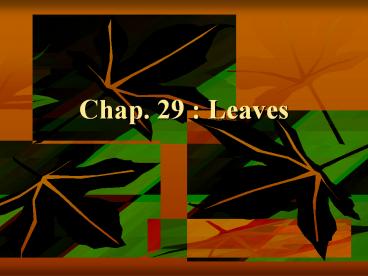Chap. 29 : Leaves - PowerPoint PPT Presentation
1 / 21
Title: Chap. 29 : Leaves
1
Chap. 29 Leaves
2
Primary Function of Leaf
- Photosynthesis depends on light, temp., and
supply of water and carbon dioxide. - 6 CO2 12 H2O light
C6H12O6 6H2O 6O2 -
(sugar) - -- Going from left to right is photosynthesis
- -- Going from right to left is respiration.
Instead of light, energy in the form of heat is
produced.
3
II. Leaf Structure
blade
vein
petiole
stipules
4
A. Types of vein patterns (venation)
- 1. Parallel monocots (1 seed leaf) ex. Corn
-
-- veins all run the same way
5
- 2. Palmate no main vein (like palm of hand)
Ex. Maples - 3. Pinnate one main vein. Ex. Locust
Dicots 2 seed leaves.
6
B. Simple vs. Compound Leaves
- 1. Compound blade made up of leaflets. One bud
for the whole leaf.
Bud
Pinnately compound
bud
Palmately compound
7
Bud new leaf -- simple leaf
Bud enclosed compound leaf.
8
2. Simple leaflet is blade
- Most trees around here. Ex. Maples, oaks,
dogwoods ( 1 bud per leaf) - C. Leaf Arrangement arrangement of each leaf on
the branch in relation to the other leaves.
9
1. Alternate 2. Opposite
- DAMB dogwoods, ashes, maples, and buckeyes.
Only ones around here with opposite arrangement.
Most trees have alternate arrangements.
10
D. Leaf Margin (edge)
- Toothed 2. Smooth or Entire
- 3. Lobed
11
III. Leaf Tissues
A
B
C
D
K
E
F
L
I
J
G
H
12
- A Epidermal hair reduces water loss, secretes
oil - B. Cuticle waxy layer prevents water loss
- C. Upper epidermis protection
- D. Palisade cells parenchyma tissue used for
photosynthesis. - E. Spongy mesophyll storage tissue stores
food,water,waste - F. Lower epidermis protection
- G. Xylem Phloem tissues that conduct (move)
things - (water) (food)
- H. Fibrovascular bundle (vein) contains
conducting tissues - I. Stomata opening for gas exchange
- J. Guard cell regulates the opening and closing
of stomata - K. Chloroplast move in counter clockwise circle
to absorb as much light as possible. - L. Air spaces contain gases CO2 and O2
13
Actual Leaf Cross-Section
14
IV. Water Loss
- -- Transpiration the losing of water through
the stomata on the leaf surface to create a
difference in turgor pressure (keeps plants
stiff) which causes water to be drawn up the stem
(capillarity).
15
V. Leaf Coloration
- A. Spring and Summer
- -- chlorophyll is produced and makes
leaves green. - B. Fall
- drop in temp. and daylight hrs. causes
chlorophyll to stop being produced so other
pigments can be seen - xanthophyll yellow
16
Carotene orange
- -- anthocyanin red
- -- chromoplast blue
- C. Winter
- -- leaves turn brown from the death of
tissue and the releasing of tannic acid.
17
VI. Falling Leaves
- Called abscission
- -- weak zone forms where petiole attaches.
Pectin (jelly) attaching petiole dissolves.
Slightest wind or pressure jars leaf. Once
fallen, a layer of cork seals the hole left by
the leaf.
18
VII. Leaf Modifications - change in leaf
structure to better suit it to its environment.
- 1. Succulent leaves fleshy holds water.
- ex. Cactus, desert plants, aloe,conifers
- 2. Tendrils used for anchorage. Ex. Vines
- 3. Insectivorous leaves designed to capture
insects. Still photosynthesis but need insects
because the soil lacks necessary nutrients. - ex. Venus flytrap
19
VIII. Plant Cells
- 3 types
- 1. Parenchyma loosely packed, flexible.
Used for photosynthesis, metabolism, and storage. - 2. Collenchyma thicker cell walls. Support.
Ex. Celery - 3. Sclerenchyma- thicker, rigid cell walls.
Support and strengthen nongrowing parts. Ex.
Covering of nuts
20
IX. Plant Tissue Systems
- 3 types
- 1. Dermal Tissue forms outside layer(s) of
plants. In woody plants also becomes the bark - 2. Ground Tissue middle layer. Made up of
all 3 plant cell types. Support, metabolism, and
storage. - 3. Vascular Tissue innermost layer.
Function in transport and support. Xylem (water
(also forms wood)) and phloem (food)
21
X. Plant Growth
- 2 kinds
- 1. Primary growth plant grows in length or
height. Done by apical(fast growing tissue in
roots) and intercalary (in stems and leaves)
meristems. - 2. Secondary growth grow in diameter or
thickness. Done by lateral meristems (adds more
tissue and wood to roots and stems)































